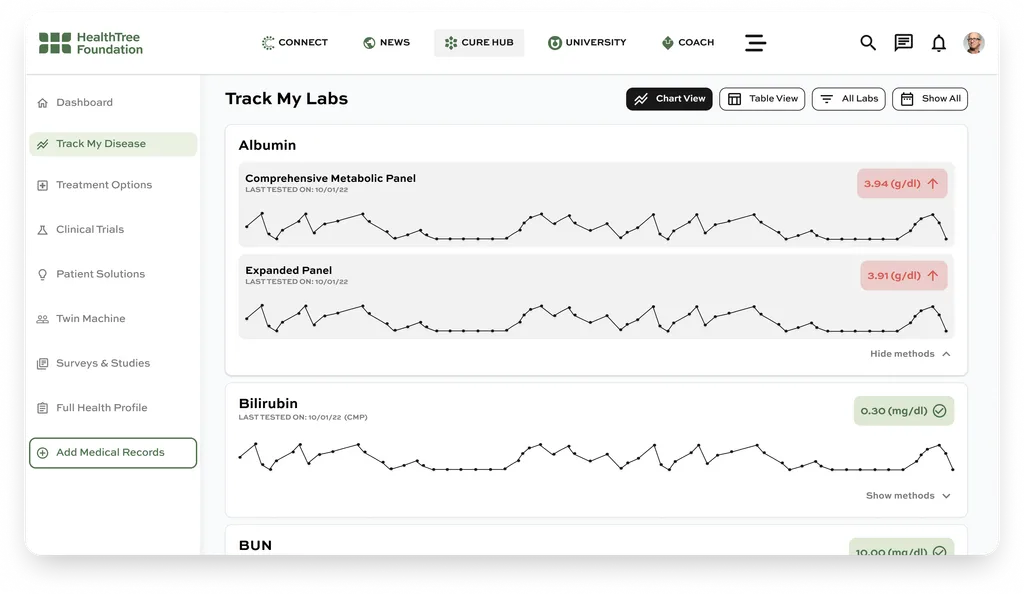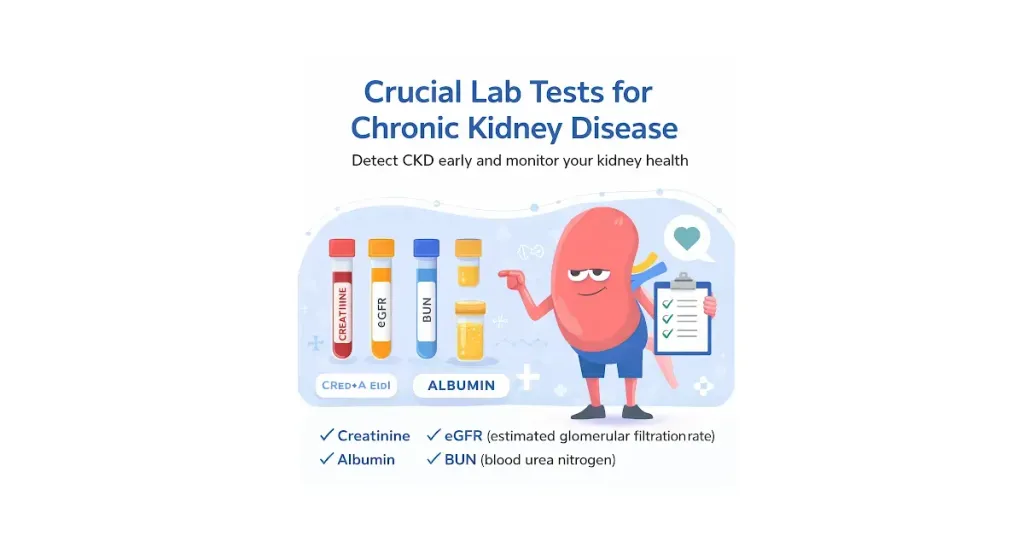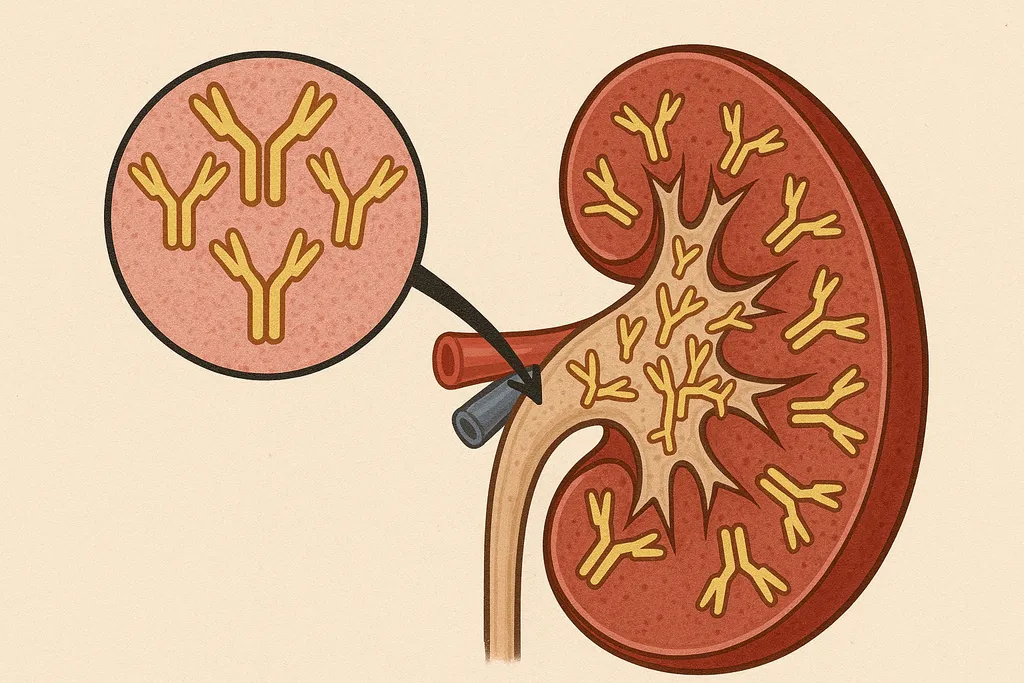What Is the Prognosis of a Multiple Myeloma Patient?

A cancer diagnosis, especially one like multiple myeloma, can raise tough questions, such as, "How long will I live with this disease?" or "What can I expect my quality of life to be?" These are important concerns that deserve thoughtful answers. Unfortunately, the prognosis for multiple myeloma isn’t always as straightforward as it might seem. Unlike other cancers, the stage at diagnosis doesn’t correlate as directly with myeloma prognosis.
We hope this article provides you with valuable insights into your prognosis and the survival rates of myeloma. At HealthTree, we believe that informed patients often enjoy longer, healthier lives. That’s why we're dedicated to bringing you the latest updates on treatments and research in myeloma, presented in a clear and accessible way. If you want to explore more free resources like this, we invite you to visit:
What Is the Prognosis and Life Expectancy for Multiple Myeloma?
Prognosis refers to the expected outcome or progression of a disease. For multiple myeloma, prognosis can give a glimpse of how well a patient might manage the disease over time. While there is no cure, the multiple myeloma prognosis has significantly improved, thanks to advances in treatments over the past 10-20 years.
The life expectancy for multiple myeloma patients depends on several factors, including the stage of the disease, genetic factors, age, and overall health. Many patients live relatively normal lives for many years, and a multiple myeloma diagnosis is no longer a death sentence.
Factors Influencing Multiple Myeloma Survival Rate
Several factors affect survival rates, including:
- Staging and Risk Stratification: The Revised International Staging System (R-ISS) evaluates multiple myeloma based on biomarkers like beta-2-microglobulin, albumin, and genetic abnormalities.
- Advances in Treatment: Chemotherapy, stem cell transplants, and immunotherapies have significantly improved outcomes. Patients who respond well to these treatments often experience better survival rates.
- Myeloma Prognosis: Some patients with slow-growing myeloma may manage the disease for many years, while others with more aggressive forms may face different challenges.
How Long Do Multiple Myeloma Patients Live?
In 2019, Dr. Rafael Fonseca, a well-known myeloma specialist, noted that many of his patients were living more than ten years with multiple myeloma. However, for those with high-risk myeloma, life expectancy was around three to five years.
Since then, new treatments such as CAR T therapy, bispecific antibodies, and other advanced therapies have provided multiple myeloma patients with better outcomes. Though the prognosis for high-risk myeloma patients still isn't optimal, their chances of living longer and improving quality of life are much higher today.
Can People Live 20 Years or More with Multiple Myeloma?
Yes, it is possible for multiple myeloma patients to live 20 years or more, especially with advancements in treatment. Some patients have lived for decades after their diagnosis.
John Bailey is one such example. Diagnosed with a poor prognosis, John has been living with myeloma for over 20 years. Thanks to breakthroughs in immunotherapy and stem cell transplants, his outlook has dramatically improved. John and his wife Ann’s story is a reminder that, while multiple myeloma is still incurable, longer survival rates are becoming more common due to innovative treatments.
For the full story of John and his incredible story, read here: Celebrating Myeloma Pioneers John and Ann Bailey.
Who Is the Longest-Living Person with Multiple Myeloma?
Identifying the longest-living person with multiple myeloma is challenging because each case is different. However, there are numerous stories of individuals surviving for several decades. Factors like early diagnosis, effective treatment, and certain genetic profiles can all contribute to longer survival.
HealthTree Founder Jenny Ahlstrom has been living with multiple myeloma for more than a decade. She attributes this longevity and high quality of life to her proactive education and learning of multiple myeloma. Learn more about her story here: Jenny Ahlstrom's Myeloma Story.
Other inspiring stories from myeloma patients, including Cindy Brown, who has also lived for a decade with myeloma, can be found here: Multiple Myeloma Patient Stories.
Does Multiple Myeloma Have a Poor Prognosis?
While multiple myeloma is considered incurable, its prognosis has improved dramatically. Since 2010, life expectancy for standard-risk multiple myeloma patients has increased from 3-5 years to over a decade. Even for high-risk cases, patients are living longer thanks to new treatments.
You can learn more about the most up-to-date myeloma survival statistics below:
The National Cancer Institute's SEER Program reports that the five-year relative survival rate for patients diagnosed with multiple myeloma between 2013 and 2019 is around 57%. This survival rate reflects advancements in treatment and early diagnosis.
Additionally, Cancer.net, a platform by the American Society of Clinical Oncology (ASCO), frequently updates survival data based on individual patient factors like age, health, and the specific characteristics of their cancer.
Lastly, Cancer Research UK indicates that survival rates for myeloma are improving, with many patients in England experiencing a 10-year survival rate due to better treatments and supportive care.
For more information about the survival rate of multiple myeloma, read the following article: What is the Multiple Myeloma Survival Rate?
Is Multiple Myeloma Considered Terminal?
Though multiple myeloma is technically a terminal illness because there is no cure, many doctors now refer to it as a chronic disease. Many patients live with multiple myeloma for years, managing it with continuous treatment.
Stages of Multiple Myeloma and Their Impact on Survival
The R-ISS staging system divides multiple myeloma into three stages based on laboratory values and genetic abnormalities:
- Stage I: Indicates a more favorable prognosis with normal albumin levels and no high-risk genetic features.
- Stage II: Intermediate risk with some abnormal biomarkers.
- Stage III: Indicates aggressive disease with higher levels of beta-2 microglobulin and high-risk genetic features.
While staging can help predict outcomes, other factors like response to treatment play a critical role in multiple myeloma survival rates.
Take Control of Your Care with HealthTree Cure Hub
You can improve your chances of a better outcome by becoming your own best advocate. Through HealthTree Cure Hub, you can track your myeloma, learn about treatment options and clinical trials, and connect with others.
Securely and privately connect your electronic health records to get started. Sign up for a free patient account today to get started.
Sources:
A cancer diagnosis, especially one like multiple myeloma, can raise tough questions, such as, "How long will I live with this disease?" or "What can I expect my quality of life to be?" These are important concerns that deserve thoughtful answers. Unfortunately, the prognosis for multiple myeloma isn’t always as straightforward as it might seem. Unlike other cancers, the stage at diagnosis doesn’t correlate as directly with myeloma prognosis.
We hope this article provides you with valuable insights into your prognosis and the survival rates of myeloma. At HealthTree, we believe that informed patients often enjoy longer, healthier lives. That’s why we're dedicated to bringing you the latest updates on treatments and research in myeloma, presented in a clear and accessible way. If you want to explore more free resources like this, we invite you to visit:
What Is the Prognosis and Life Expectancy for Multiple Myeloma?
Prognosis refers to the expected outcome or progression of a disease. For multiple myeloma, prognosis can give a glimpse of how well a patient might manage the disease over time. While there is no cure, the multiple myeloma prognosis has significantly improved, thanks to advances in treatments over the past 10-20 years.
The life expectancy for multiple myeloma patients depends on several factors, including the stage of the disease, genetic factors, age, and overall health. Many patients live relatively normal lives for many years, and a multiple myeloma diagnosis is no longer a death sentence.
Factors Influencing Multiple Myeloma Survival Rate
Several factors affect survival rates, including:
- Staging and Risk Stratification: The Revised International Staging System (R-ISS) evaluates multiple myeloma based on biomarkers like beta-2-microglobulin, albumin, and genetic abnormalities.
- Advances in Treatment: Chemotherapy, stem cell transplants, and immunotherapies have significantly improved outcomes. Patients who respond well to these treatments often experience better survival rates.
- Myeloma Prognosis: Some patients with slow-growing myeloma may manage the disease for many years, while others with more aggressive forms may face different challenges.
How Long Do Multiple Myeloma Patients Live?
In 2019, Dr. Rafael Fonseca, a well-known myeloma specialist, noted that many of his patients were living more than ten years with multiple myeloma. However, for those with high-risk myeloma, life expectancy was around three to five years.
Since then, new treatments such as CAR T therapy, bispecific antibodies, and other advanced therapies have provided multiple myeloma patients with better outcomes. Though the prognosis for high-risk myeloma patients still isn't optimal, their chances of living longer and improving quality of life are much higher today.
Can People Live 20 Years or More with Multiple Myeloma?
Yes, it is possible for multiple myeloma patients to live 20 years or more, especially with advancements in treatment. Some patients have lived for decades after their diagnosis.
John Bailey is one such example. Diagnosed with a poor prognosis, John has been living with myeloma for over 20 years. Thanks to breakthroughs in immunotherapy and stem cell transplants, his outlook has dramatically improved. John and his wife Ann’s story is a reminder that, while multiple myeloma is still incurable, longer survival rates are becoming more common due to innovative treatments.
For the full story of John and his incredible story, read here: Celebrating Myeloma Pioneers John and Ann Bailey.
Who Is the Longest-Living Person with Multiple Myeloma?
Identifying the longest-living person with multiple myeloma is challenging because each case is different. However, there are numerous stories of individuals surviving for several decades. Factors like early diagnosis, effective treatment, and certain genetic profiles can all contribute to longer survival.
HealthTree Founder Jenny Ahlstrom has been living with multiple myeloma for more than a decade. She attributes this longevity and high quality of life to her proactive education and learning of multiple myeloma. Learn more about her story here: Jenny Ahlstrom's Myeloma Story.
Other inspiring stories from myeloma patients, including Cindy Brown, who has also lived for a decade with myeloma, can be found here: Multiple Myeloma Patient Stories.
Does Multiple Myeloma Have a Poor Prognosis?
While multiple myeloma is considered incurable, its prognosis has improved dramatically. Since 2010, life expectancy for standard-risk multiple myeloma patients has increased from 3-5 years to over a decade. Even for high-risk cases, patients are living longer thanks to new treatments.
You can learn more about the most up-to-date myeloma survival statistics below:
The National Cancer Institute's SEER Program reports that the five-year relative survival rate for patients diagnosed with multiple myeloma between 2013 and 2019 is around 57%. This survival rate reflects advancements in treatment and early diagnosis.
Additionally, Cancer.net, a platform by the American Society of Clinical Oncology (ASCO), frequently updates survival data based on individual patient factors like age, health, and the specific characteristics of their cancer.
Lastly, Cancer Research UK indicates that survival rates for myeloma are improving, with many patients in England experiencing a 10-year survival rate due to better treatments and supportive care.
For more information about the survival rate of multiple myeloma, read the following article: What is the Multiple Myeloma Survival Rate?
Is Multiple Myeloma Considered Terminal?
Though multiple myeloma is technically a terminal illness because there is no cure, many doctors now refer to it as a chronic disease. Many patients live with multiple myeloma for years, managing it with continuous treatment.
Stages of Multiple Myeloma and Their Impact on Survival
The R-ISS staging system divides multiple myeloma into three stages based on laboratory values and genetic abnormalities:
- Stage I: Indicates a more favorable prognosis with normal albumin levels and no high-risk genetic features.
- Stage II: Intermediate risk with some abnormal biomarkers.
- Stage III: Indicates aggressive disease with higher levels of beta-2 microglobulin and high-risk genetic features.
While staging can help predict outcomes, other factors like response to treatment play a critical role in multiple myeloma survival rates.
Take Control of Your Care with HealthTree Cure Hub
You can improve your chances of a better outcome by becoming your own best advocate. Through HealthTree Cure Hub, you can track your myeloma, learn about treatment options and clinical trials, and connect with others.
Securely and privately connect your electronic health records to get started. Sign up for a free patient account today to get started.
Sources:

about the author
Audrey Burton-Bethke
Audrey is a content writer and editor for the HealthTree Foundation. She originally joined the HealthTree Foundation in 2020. Audrey loves spending time with her supportive husband, energetic four-year-old, and new baby.
More on Core Education
Trending Articles
Upcoming Events




Get the Latest Multiple Myeloma Updates, Delivered to You.
By subscribing to the HealthTree newsletter, you'll receive the latest research, treatment updates, and expert insights to help you navigate your health.
Together we care.
Together we cure.
3x Faster.














